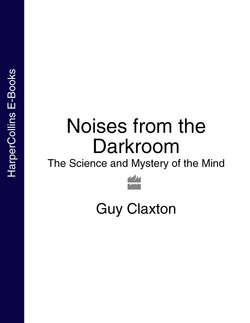Читать книгу Noises from the Darkroom: The Science and Mystery of the Mind - Guy Claxton - Страница 10
The See-Through Mind
ОглавлениеThe cornerstone of contemporary folk psychology is the assumption that the mind is see-through: that when we look inward, through the window of introspection, we see what is there. We imagine the mind to be like a clock in a glass case, with all its important workings available for inspection by its one privileged owner. We think we know ourselves already, or could know ourselves if we chose, if not completely, then at least intimately and directly. This is the cardinal misconception, and its appreciation forms the starting point for the exposé with which this book is concerned.
Contrary to popular opinion, the human mind is a closed book. The room behind the eyes is forever dark. No access is possible, either by thinking or via the senses – for thoughts and experiences are the produce of this obscure factory, not glimpses of its operation. As with the manufacture of Cointreau or Tabasco, what goes on behind the scenes is a jealously guarded trade secret. All we get to do is taste the concoction; to the world of the concocter we are not privy at all. In the mind feelings are fabricated, thoughts are marshalled, perceptual pictures are painted. But of the painter and the engineer we have no idea.
Or rather, we can only have ideas. We think we are looking at ourselves through transparent windows. We think that consciousness gives us privileged access to our process and our nature: that the dark-room of the mind is light and airy, and our natural home. We think that the stories it tells about itself are true. Yet we are not looking through clear glass. We are looking at a screen on which some rather special products of the mind’s activity are back-projected. Behind the screen there is a director producing a constant stream of interwoven films, one of which – one recurring theme – concerns the work of a director making a constant stream of interwoven films. As in Frederico Fellini’s masterpiece 8 1/2, we are not seeing the director at work, but only the director’s partial and fictionalized view of a hypothetical director at work. We are invited to believe that the fictional and factual Fellinis are one and the same. But we have no right to do so, and we can never know the degree to which they really correspond—for the real Fellini remains always beyond the filmgoers’ ken.
If the images that the mind created of itself were truthful – if the pictures projected onto the blind showed what we would actually see if the blind were raised – then nothing would be lost by mistaking one for the other. If appearance matches reality, the distinction becomes unimportant, indeed loses its meaning. But if the mind dissembles, then the consequences of buying its pronouncements may be more interesting, perhaps more serious. If the mind tells you that you are 5 feet 3 inches tall, and take a 14 inch collar, when you are really 6 foot and a 16, then you are going to bang your head on a lot of lintels, and buy a lot of clothes that leave you with cold ankles and restricted breathing. Like the man suffering from a perpetual headache, the only doctor who is going to be able to help you is the one who persuades you to buy bigger shirts.
Inside the dark-room, inscrutable though it is, are collected all the data and beliefs that give life its meaning and construct its purpose. Buried there are the files that tell us how to be happy, who and what to care about, when to react and when to keep still; the programs that enable us to understand language, to record the past, to spin fantasies, and to tell the ‘real’ from the ‘imaginary’. Manifesting indirectly, in attractions and expectations, spontaneous allegiances and solitary dreams, there are the casts of mind that tell us how to recognize a human being who will take care of us, or give us sexual pleasure; how to feel when Arsenal lose the Cup (‘Ecstatic’, ‘Destroyed’, ‘What’s “arsenal”? What “cup”?’) And somewhere right at the centre of operations is the unarticulated specification of what it means to be a person: what kind of a being is a human being. From the frisson of an impulse buy, to the image of a Good Death, all is fashioned by the back-room boys and girls of the human mind.
